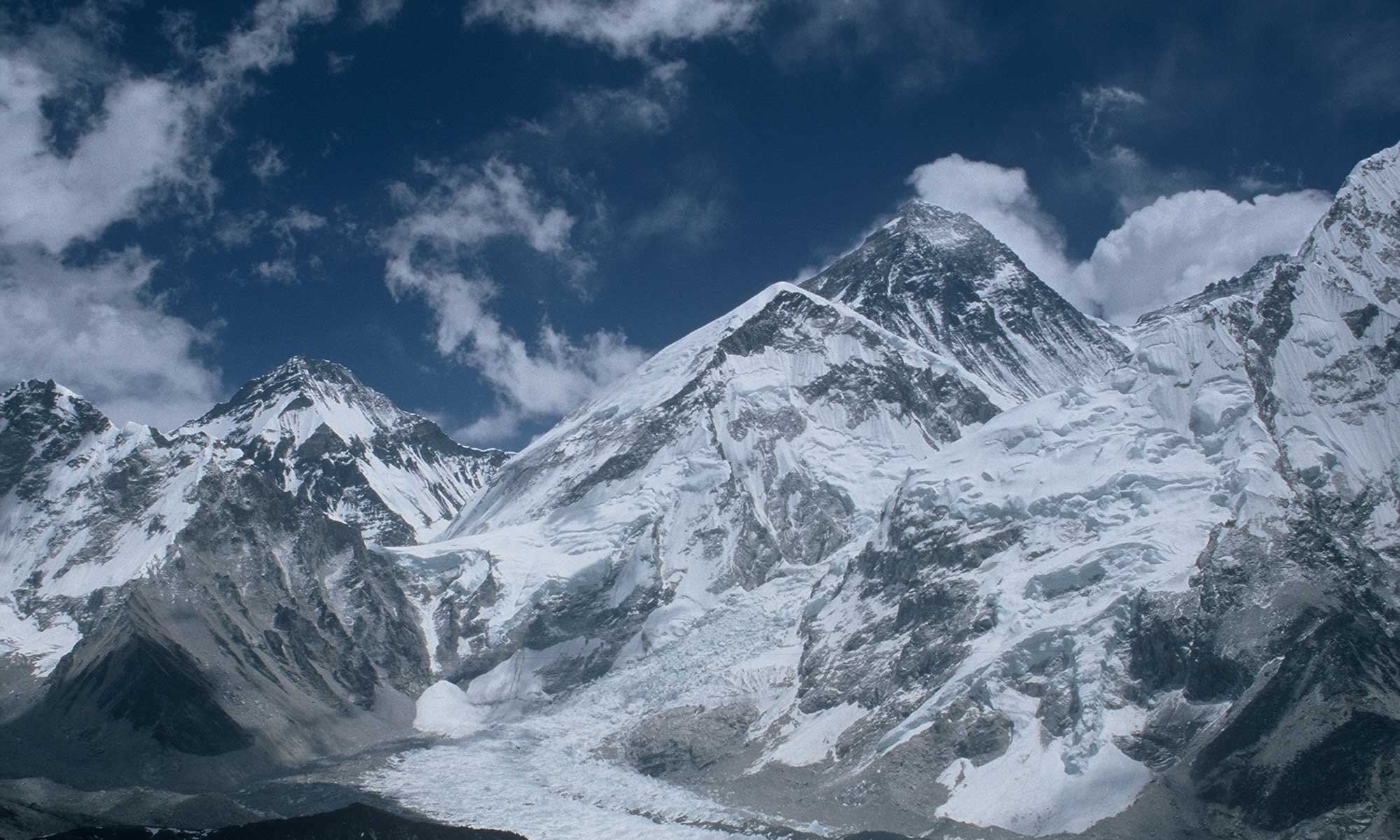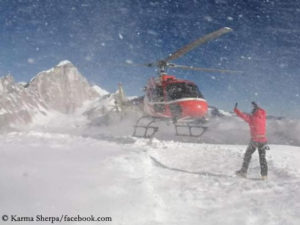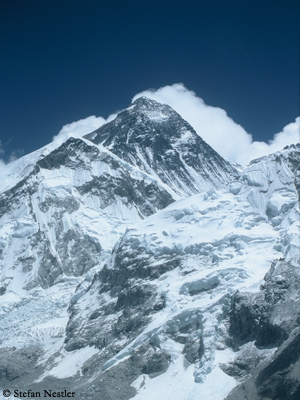“Khumbu mosquitoes” – that’s what legendary Austrian expedition leader Wolfgang Nairz called the helicopters in the Everest region some time ago when we were talking about the increasing aircraft noise in the Khumbu. “It’s a constant whirring in the air,” the 78-year-old told me. Among others, Nairz led that Everest expedition in spring 1978, during which Reinhold Messner and Peter Habeler became the first people to reach the summit at 8,849 meters without bottled oxygen, and during which Reinhard Karl – using a breathing mask – also became the first German to stand on the highest point on earth.
I was in the Khumbu for the first time more than 20 years ago. I count the increase in aircraft noise as one of the most noticeable changes in the region around the highest mountain on earth. Without helicopters, there seems to be very little going on in the Khumbu.
This was evident prior to the 2023 spring season, when the local government temporarily restricted air service to Everest Base Camp to support traditional transportation by yaks and porters. Expedition organizers sounded the alarm – and were heard.
The modern yaks
In the end, the Everest season of the commercial expeditions got off to a smooth start. Helicopters, the “modern yaks”, play an increasingly important role: expedition material is flown to base camp, equipment such as ropes, snow pickets or oxygen bottles further up to Camp 2 (6,400 meters). In addition, pre-acclimatized clients of commercial teams are brought to base camp by helicopter, while others are flown to Namche Bazaar, the main village in the Khumbu, or even to Kathmandu, to refuel with oxygen.
Seven landing sites
In addition, there are rescue missions by helicopter on the mountain as well as the onward transport of patients to hospitals in Lukla or Kathmandu. As I learned firsthand, there were five official and two unofficial helicopter landing pads at base camp last spring season. And even those were barely enough on some days. There was also a lot of air traffic on the mountain: 20 to 30 flights per day up to Camp 2 were counted.
But passenger transports are still the exception. In spring 2014 – when the season ended prematurely after 16 Nepalese climbers died in an avalanche accident in the Khumbu Icefall – Chinese climber Wang Jing and Brazilian-American climber Cleo Weidlich had themselves flown directly to Camp 2 with their Sherpas. Wang reached the summit of Everest, and the chronicle Himalayan Database recorded her ascent as “helicopter-assisted ascent and descent.”
Heli-doping
Even after the spring 2019 season, renowned Nepalese mountaineer and mountain guide Dawa Yangzum Sherpa spoke to National Geographic magazine of climbers “who take a helicopter to skip crossing the Khumbu Icefall.”
There was a similar case in fall 2020 on the eight-thousander Manaslu in western Nepal, when at least one, possibly more climbers from a team of Bahrain’s Royal Guard were dropped off by helicopter directly at Camp 1 at 5,700 meters. I called it heli-doping back then.
Wall of silence
The Nepalese operator Seven Summit Treks (SST) did not respond to my inquiry at the time. Nor did they now when I asked whether not only equipment but also climbers had been flown to the high camp during the ascent of Manaslu by the team of the Norwegian Kristin Harila at the beginning of June.
Mingma Gyalje Sherpa, head of the expedition operator Imagine Nepal, had claimed as much on Instagram, uploading a video that he said had been taken on 8 June by residents of Samagaon village who had been searching for Yartsa Gunbu on an opposite hillside. The caterpillar fungus, which is found only in the Himalayas, is coveted – in part because of its alleged aphrodisiac effect – and can be sold at a high price.
Dropped down and tracked up and down?
The video shows a helicopter landing on the Manaslu glacier at the level of Camp 2 at about 6,300 meters. “Climbing down is easier than climbing up. Good technique. This is also ruining Sherpa historical name and fame,” Mingma raged.
The next day, he doubled down. On Annapurna, he said, two Sherpas who had previously been involved in the retrieval of German climber Luis Stitzinger, who died on Kangchenjunga, were flown directly to Camp 3 to support Harila’s team.
He cited a social media post by one of Harila’s former team members as evidence. “I clearly mention I am against dropping sherpa team in Camp 2 or 3 and opening routes from there upward and downward,“ Mingma said, summing up his criticism. „Climbing has to go from base (camp) to summit and base (camp), not from the middle to summit and middle to base (camp).“
Harila refers only to herself
Harila’s team also did not answer my questions about the helicopter flights. The Norwegian spoke on Instagram of “false accusations” by Mingma against her personally: “Long story short, did I heli up to higher camps? No. You can look at my climbing tracker data for proof. I of course also have other evidence such as time stamped footage and the Sherpa witnesses.”
Kristin did not explicitly address Mingma’s accusation that some of her team members had been flown to high camps on Annapurna and Manaslu. She spoke only of how not only her own reputation was under attack, but also that of SST and her team’s Sherpas.
Flight control does not respond to request
All helicopter movements and landings have to be reported to the Nepalese air traffic control. I asked the responsible air traffic authority CAAN for information about the helicopter flights on Annapurna and Manaslu at the beginning of June. I did not receive an answer from there either. This hardly surprises me. Nepalese government agencies rarely respond to requests from foreign journalists.
Seven Summit Treks, by the way, has no problem relying on helicopters for expeditions. SST chief Mingma Sherpa is vice chairman of the Heli Everest company, and SST managing director Tashi Lakpa sits on the helicopter company’s management board.
From heli-yoga to heli-climbing
“So what?” many will say, “Look to the Alps or other high mountains, such as in Alaska, the Canadian Rockies or in New Zealand. Helicopter operations are routine there, too, and not just in mountaineering!” Skiers let themselves be dropped off by helicopter over virgin snow slopes (heli-skiing), mountain bikers on peaks so they only have to ride down (heli-biking), mountain hikers at remote points to start from (heli-hiking), yogis to do their exercises in solitude (heli-yoga). So why not heli-climbing, these people will ask.
Landing of the “Yeti” on Dhaulagiri
And possibly add that in earlier times there had already been flight-assisted mountaineering. During the first ascent of Dhaulagiri in 1960 by an expedition led by the Swiss Max Eiselin, climbers and gear were flown by a single-engine small plane, a prototype Pilatus Porter, to the Dhampus Pass at around 5,250 meters, and the climbers were later flown even up to Dhaulagiri Northeast Col at 5,650 meters. To this day, this is an altitude record for the landing of a so-called fixed-wing aircraft – in contrast to a rotary-wing aircraft, i.e. helicopter.
In the course of the expedition the aircraft, named “Yeti”, was so demolished during an emergency landing that it could no longer take off. The pilots remained unharmed. Even today, some wreckage of the “Yeti” lies at the site of the accident on Dhaulagiri, where its flight path ended. In contrast to today’s use of helicopters on eight-thousanders, which are becoming more and more routine, the use of the “Yeti” was a pioneering act of aviation. A premiere, an adventure of its own with an uncertain outcome, an experiment that both succeeded and failed.
Ticket to Camp 2 for 4,000 dollars
That more than 60 years later helicopters would play such a major role in expeditions in the Himalayas could not have been foreseen at the time. Until a few years ago, only helicopter rescue flights were allowed on the slopes of the world’s highest mountains. This, too, has now become a lucrative business in Nepal. Rescuing a dead or injured person from high altitude costs tens of thousands of dollars.
Since the avalanche accident in the Khumbu Icefall in 2014, the number of material flights up to Camp 1 or 2 has steadily increased. And the day is probably not far off when no porters will shoulder any more equipment to carry it through the dangerous Khumbu Icefall to high camp, and instead everything will be flown up by helicopter.
In the end also the climbers? Quite possibly. Hungarian climber Szilard Suhajda – who later died trying to scale Everest without bottled oxygen and a Sherpa companion – reported in mid-May that climbers had been flown up to Camp 2 by helicopter again this year. The one-way ticket had cost $4,000.
No one asks about ecological footprint
This has nothing to do with sustainable mountaineering in times of climate change. Yet that is exactly what is needed to protect the fragile ecosystem in the Himalayas. But this debate has not yet gained momentum. What applies to the European Alps is repeated in the Himalayas: The cow is milked as long as it gives milk. And in the process, it is swarmed by Khumbu mosquitoes.
P.S.: During the current summer season in the Karakoram in Pakistan there will be much less aircraft noise than in Nepal in spring. The reason: Due to the ongoing political tensions with India, civilian flights are prohibited in the northern border area between the two countries. Only army helicopters are allowed to take off there, and rescue missions are also carried out by the Pakistani military.








The Sherpas keep going on about global warming changing Everest and impacting Nepal, but they are the ones making it worse. They encourage people to fly around the world for a holiday, then fly them around the Khumbu in unnecessary and invasive flights.
Intensive helicopter flights so directly over glaciers has an impact:
https://www.euronews.com/green/2022/02/23/what-is-black-carbon-and-how-is-it-changing-the-face-of-antarctica
https://polarjournal.ch/en/2022/02/24/research-and-tourism-leave-soot-deposits-in-antarctica/
https://www.themandarin.com.au/182531-sooty-trail-of-tourism-pollution-may-be-melting-antarctica/
https://www.themandarin.com.au/182531-sooty-trail-of-tourism-pollution-may-be-melting-antarctica/